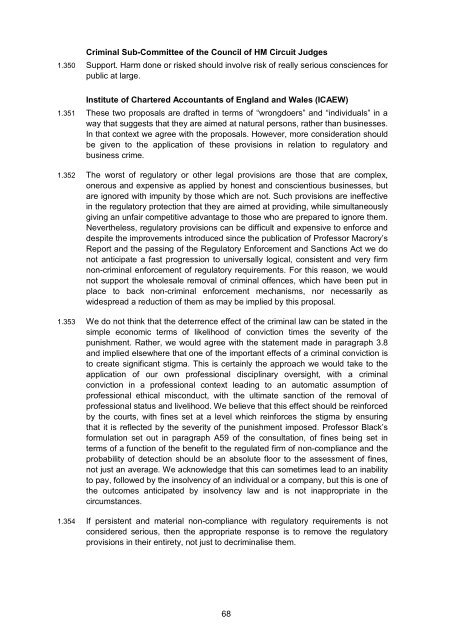Criminal Liability in Regulatory Contexts Responses - Law ...
Criminal Liability in Regulatory Contexts Responses - Law ...
Criminal Liability in Regulatory Contexts Responses - Law ...
Create successful ePaper yourself
Turn your PDF publications into a flip-book with our unique Google optimized e-Paper software.
<strong>Crim<strong>in</strong>al</strong> Sub-Committee of the Council of HM Circuit Judges<br />
1.350 Support. Harm done or risked should <strong>in</strong>volve risk of really serious consciences for<br />
public at large.<br />
Institute of Chartered Accountants of England and Wales (ICAEW)<br />
1.351 These two proposals are drafted <strong>in</strong> terms of “wrongdoers” and “<strong>in</strong>dividuals” <strong>in</strong> a<br />
way that suggests that they are aimed at natural persons, rather than bus<strong>in</strong>esses.<br />
In that context we agree with the proposals. However, more consideration should<br />
be given to the application of these provisions <strong>in</strong> relation to regulatory and<br />
bus<strong>in</strong>ess crime.<br />
1.352 The worst of regulatory or other legal provisions are those that are complex,<br />
onerous and expensive as applied by honest and conscientious bus<strong>in</strong>esses, but<br />
are ignored with impunity by those which are not. Such provisions are <strong>in</strong>effective<br />
<strong>in</strong> the regulatory protection that they are aimed at provid<strong>in</strong>g, while simultaneously<br />
giv<strong>in</strong>g an unfair competitive advantage to those who are prepared to ignore them.<br />
Nevertheless, regulatory provisions can be difficult and expensive to enforce and<br />
despite the improvements <strong>in</strong>troduced s<strong>in</strong>ce the publication of Professor Macrory’s<br />
Report and the pass<strong>in</strong>g of the <strong>Regulatory</strong> Enforcement and Sanctions Act we do<br />
not anticipate a fast progression to universally logical, consistent and very firm<br />
non-crim<strong>in</strong>al enforcement of regulatory requirements. For this reason, we would<br />
not support the wholesale removal of crim<strong>in</strong>al offences, which have been put <strong>in</strong><br />
place to back non-crim<strong>in</strong>al enforcement mechanisms, nor necessarily as<br />
widespread a reduction of them as may be implied by this proposal.<br />
1.353 We do not th<strong>in</strong>k that the deterrence effect of the crim<strong>in</strong>al law can be stated <strong>in</strong> the<br />
simple economic terms of likelihood of conviction times the severity of the<br />
punishment. Rather, we would agree with the statement made <strong>in</strong> paragraph 3.8<br />
and implied elsewhere that one of the important effects of a crim<strong>in</strong>al conviction is<br />
to create significant stigma. This is certa<strong>in</strong>ly the approach we would take to the<br />
application of our own professional discipl<strong>in</strong>ary oversight, with a crim<strong>in</strong>al<br />
conviction <strong>in</strong> a professional context lead<strong>in</strong>g to an automatic assumption of<br />
professional ethical misconduct, with the ultimate sanction of the removal of<br />
professional status and livelihood. We believe that this effect should be re<strong>in</strong>forced<br />
by the courts, with f<strong>in</strong>es set at a level which re<strong>in</strong>forces the stigma by ensur<strong>in</strong>g<br />
that it is reflected by the severity of the punishment imposed. Professor Black’s<br />
formulation set out <strong>in</strong> paragraph A59 of the consultation, of f<strong>in</strong>es be<strong>in</strong>g set <strong>in</strong><br />
terms of a function of the benefit to the regulated firm of non-compliance and the<br />
probability of detection should be an absolute floor to the assessment of f<strong>in</strong>es,<br />
not just an average. We acknowledge that this can sometimes lead to an <strong>in</strong>ability<br />
to pay, followed by the <strong>in</strong>solvency of an <strong>in</strong>dividual or a company, but this is one of<br />
the outcomes anticipated by <strong>in</strong>solvency law and is not <strong>in</strong>appropriate <strong>in</strong> the<br />
circumstances.<br />
1.354 If persistent and material non-compliance with regulatory requirements is not<br />
considered serious, then the appropriate response is to remove the regulatory<br />
provisions <strong>in</strong> their entirety, not just to decrim<strong>in</strong>alise them.<br />
68
















